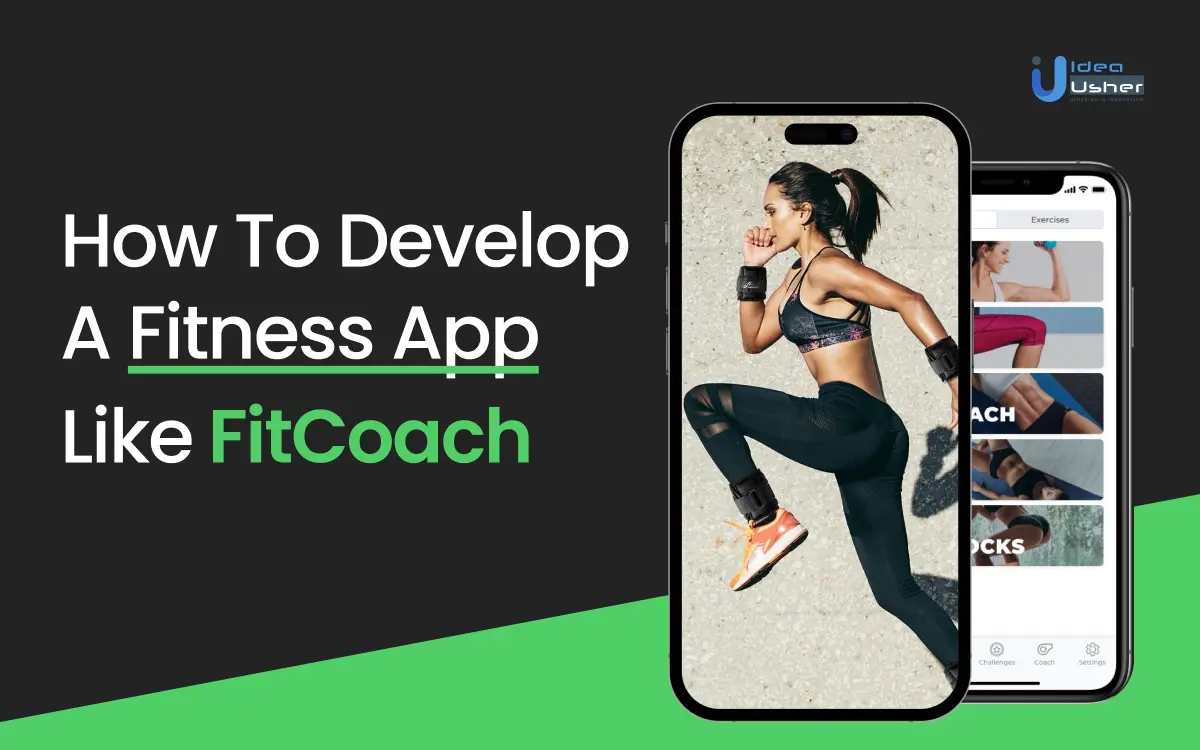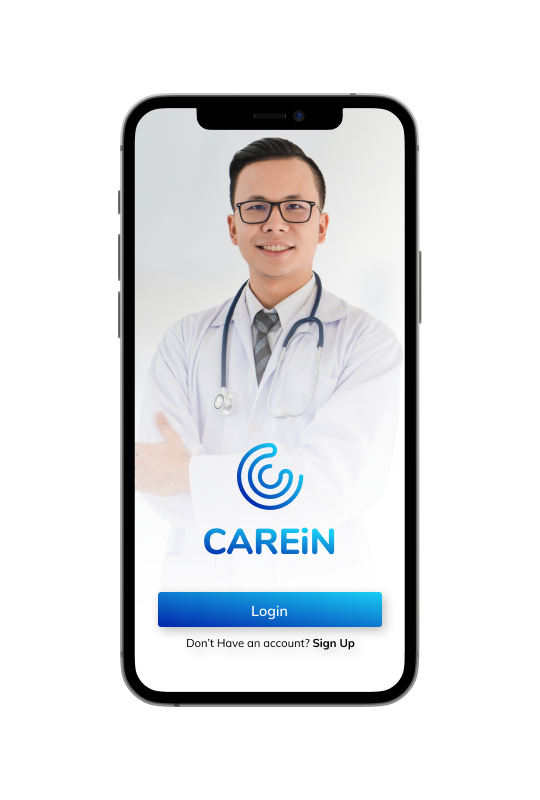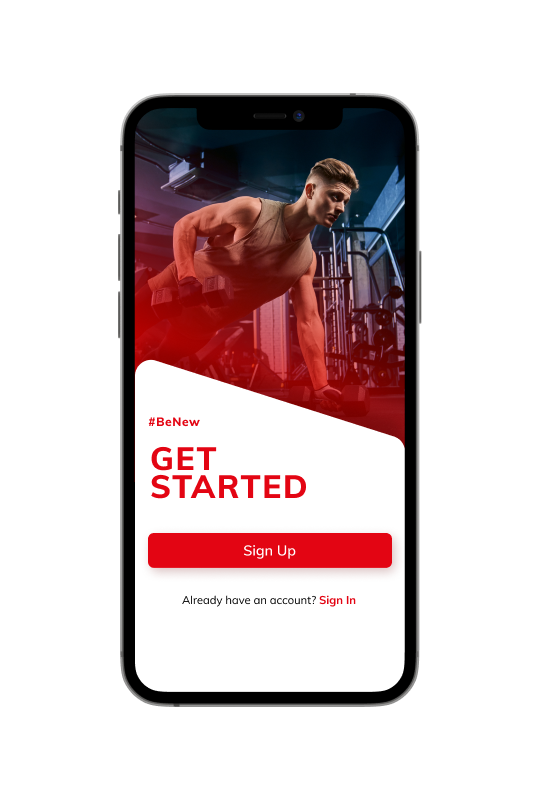Recently, the popularity of fitness apps has surged as they play a pivotal role in encouraging users to establish consistent exercise habits and enhance their physical activity levels.
FitCoach, standing out as a preferred choice, addresses the evolving preferences of users by offering accessible training techniques and accommodating lifestyle adjustments in the digital age.
These figures underscore the escalating demand for fitness apps, signaling a lucrative opportunity for industry leaders.
In response to this trend, businesses are gearing up to seize the potential of this expanding market by investing in the development of fitness apps. If you are contemplating the creation of a fitness app similar to FitCoach for your fitness business, explore this comprehensive blog for valuable insights.
The blog aims to provide valuable information on various aspects of fitness app development, including steps, features, tech stack, and more.
What is a FitCoach App?
FitCoach is a comprehensive fitness application designed to cater to the diverse needs of individuals striving to improve their health and well-being. The app is a valuable resource for anyone seeking effective ways to get in shape, shed excess weight, embark on a new fitness routine, and ultimately enhance their overall wellness. At the core of FitCoach’s offerings is its renowned 28-day workout regimen, providing users with a structured and easy-to-follow plan that incorporates physical exercises, dietary guidance, and lifestyle tips.
One of the key advantages of FitCoach is its flexibility, making it an ideal choice for those with busy schedules who find it challenging to make time for traditional gym visits. By bringing the gym experience to the palm of one’s hand, the app caters to the needs of individuals who are committed to their health but face time constraints. This accessibility factor sets FitCoach apart, allowing users to engage in effective workouts and make positive lifestyle changes without the limitations of a physical gym.
Moreover, FitCoach is well-suited for individuals on a weight loss journey, providing tailored support and guidance. The app goes beyond merely offering exercise routines by integrating dietary recommendations and essential body care advice. This holistic approach contributes to a more comprehensive and sustainable approach to health improvement, empowering users to make informed choices that align with their fitness goals.
FitCoach is not just a fitness app; it’s a wellness companion for those who aspire to prioritize their health amidst the demands of modern life. Whether users are beginners taking their first steps toward a healthier lifestyle or fitness enthusiasts looking for a convenient and effective solution, FitCoach stands as a versatile and user-friendly platform dedicated to fostering positive transformations in both body and mind.
How Does A Fitness App like FitCoach Work?
Fitness apps like FitCoach typically integrate various features and functionalities to provide users with a comprehensive and personalized fitness experience. Here’s a simplified overview of how these apps generally work:
1. User Profile Creation
Initiating the fitness app journey involves users crafting a detailed profile, encompassing crucial personal data. Beyond standard information like age, gender, and weight, users may input specifics related to their exercise history, preferred workout styles, and any existing health conditions. This multifaceted profile serves as the foundation for tailoring a bespoke fitness experience, ensuring that subsequent workout plans align with individual preferences and health considerations.
2. Fitness Assessment
Prior to diving into workout routines, many fitness apps conduct a thorough fitness assessment. This process goes beyond simple data entry, often involving interactive quizzes, lifestyle inquiries, and even basic physical tests. By gauging the user’s current physical condition and capabilities, the app gains valuable insights to create an initial baseline. This personalized approach ensures that subsequent fitness recommendations are not only effective but also mindful of the user’s unique starting point.
3. Goal Setting
User engagement is heightened when fitness goals are both specific and attainable. Fitness apps encourage users to define clear objectives, whether it’s shedding pounds, building muscle, enhancing endurance, or achieving an overall sense of well-being. This goal-setting phase lays the groundwork for the app to formulate a meticulously tailored workout and nutrition plan. Users are empowered with a sense of purpose, driving motivation throughout their fitness journey.
4. Workout Plans
Drawing on the wealth of user data, fitness apps meticulously craft personalized workout plans. These plans extend beyond generic routines, encompassing a diverse array of exercises, varying intensity levels, and strategically timed rest intervals. To facilitate seamless execution, some apps integrate video demonstrations and step-by-step instructions, ensuring users perform each exercise with precision. This curated approach transforms workouts into engaging and effective experiences, catering to individual fitness goals.
5. Progress Tracking
The journey towards fitness is incomplete without comprehensive progress tracking. Fitness apps diligently record and analyze user achievements over time. This includes monitoring completed workouts, tracking changes in weight and measurements, and visually representing performance improvements through graphs and charts. This feedback loop not only celebrates accomplishments but also enables users to refine their fitness strategies based on tangible results.
6. Nutritional Guidance
Recognizing the symbiotic relationship between exercise and nutrition, fitness apps extend support beyond the gym. Many apps offer nutritional guidance, presenting users with tailored meal plans, facilitating calorie tracking, and providing dietary recommendations. Integration with third-party nutrition databases streamlines the process of logging food intake, offering a holistic approach to health and wellness.
7. Integration with Wearables
In a tech-savvy era, fitness apps seamlessly integrate with wearables such as smartwatches and fitness trackers. This integration unlocks real-time monitoring of activities, heart rate, and other pertinent data. The synergy between the app and wearables enhances user experience, providing a comprehensive overview of their fitness journey and fostering a sense of connectivity with their physical well-being.
8. Social Features
Beyond individual pursuits, fitness apps foster a sense of community through social elements. Features like community forums, challenges, and sharing platforms create a virtual fitness ecosystem. Users connect with like-minded individuals, share personal achievements, and participate in challenges, cultivating a supportive environment that enhances motivation and commitment to their fitness goals.
9. Reminders and Notifications
To sustain user engagement and consistency, fitness apps leverage reminders and notifications strategically. Users receive prompts for upcoming workouts, meal times, and hydration goals. These gentle nudges serve as motivational cues, reinforcing the app’s role as a proactive fitness companion and encouraging users to stay on track.
10. Data Analysis and Recommendations
At the core of advanced fitness apps lies the power of data analytics and machine learning algorithms. These tools dissect user behavior and performance trends, enabling the app to make intelligent recommendations. Whether adjusting workout plans based on evolving fitness levels or optimizing strategies for better results, data-driven insights elevate the app’s ability to guide users on their fitness journey effectively.
Must-Have Features In A Fitness App Like FitCoach
Enhance the performance of your fitness app with a set of critical features inspired by FitCoach’s success. Discover the must-have features that will catapult your app to the top of the fitness tech field in this area.
1. Goal Setting
Incorporating a robust goal-setting feature is fundamental for a fitness app’s success. Empower users to define personalized fitness objectives, whether it’s weight loss, muscle gain, or endurance improvement. Enhance motivation by enabling users to set realistic milestones and track their progress seamlessly. A feature-rich goal-setting module could include visualizations, such as progress graphs and achievement badges, creating a sense of accomplishment. Integrating with smartwatch fitness trackers ensures real-time data synchronization, fostering a holistic approach to achieving fitness goals.
2. Workout Videos and Tips
Differentiating your fitness app involves going beyond mere exercise tracking. Embed educational content like workout videos and health tips to engage users comprehensively. Provide diverse workout routines catering to various fitness levels and goals. Including meditation sessions and nutritional advice elevates the app’s value, promoting a holistic approach to wellness. Ensure a user-friendly interface for accessing this content, encouraging users to explore and adopt healthier lifestyles beyond conventional exercise routines.
3. Workout Menus
Crafting an intuitive workout menu is pivotal for user engagement. Customize menus with concise yet informative explanations of each exercise, making it accessible for users of all fitness levels. Implement a creative approach, such as categorizing workouts by intensity, duration, or specific muscle groups. A personalized workout experience fosters user commitment, allowing them to tailor routines to their preferences. An aesthetically pleasing and easy-to-navigate interface enhances the overall user experience, making the fitness journey enjoyable and sustainable.
4. Geolocation
Geolocation features add a dynamic dimension to fitness apps, especially for outdoor enthusiasts. Collaborate with dedicated developers to integrate geolocation capabilities, enabling users to monitor their walking, running, and cycling routes using local maps. This feature not only encourages users to explore new territories but also promotes a sense of accomplishment as they traverse greater distances. Integrate real-time data tracking with geolocation, offering users insights into their outdoor activities, creating a unique and immersive fitness experience.
5. Workout Database
A comprehensive and relevant database is the backbone of a successful fitness app. Tailor your app’s content to suit the demographics and interests of your target audience. Offering a diverse range of workout options, nutrition plans, and health-related articles ensures users find content aligned with their preferences. Regularly update the database to keep the app fresh and engaging, preventing user abandonment due to limited choices. A personalized and varied content selection contributes significantly to user satisfaction, making your fitness app a go-to resource for diverse fitness enthusiasts.
6. Push Notifications
Utilize push notifications strategically to keep users motivated and on track with their fitness routines. Provide customizable notification settings, allowing users to choose the frequency and timing of reminders. Motivational messages, workout suggestions, and progress updates can serve as powerful nudges, fostering consistency in users’ fitness journeys. Strike a balance between encouragement and non-intrusiveness to enhance the user experience and promote long-term app engagement.
7. Integration with Third-Party Apps
Elevate the user experience by integrating your fitness app with popular third-party applications. Synchronization with health and wearable devices, such as Fitbit, creates a seamless fitness ecosystem. This integration enables users to receive comprehensive insights into their health metrics, including calories burned, heart rate, and oxygen levels. By facilitating data exchange between devices and apps, your fitness app becomes an integral part of users’ daily lives, contributing to a more personalized and interconnected fitness journey.
8. Social Media Integration
Harness the power of social media to foster a sense of community within your fitness app. Enable users to connect their app profiles with their social networks, facilitating easy sharing of achievements, workout routines, and progress updates. Implement relevant hashtags to encourage users to share their fitness journey on platforms like Facebook, creating a supportive online community. Leveraging social media integration enhances user engagement, as individuals can inspire and motivate each other, turning your fitness app into a collaborative and encouraging platform.
How To Develop A Fitness App Like FitCoach?
Discover the steps to crafting a successful fitness app like FitCoach with our step-by-step guide with key insights and a roadmap to navigate the development process effectively.
1. In-Depth Competitors Analysis
To ensure your fitness app, akin to FitCoach, stands out in the competitive market, conducting a thorough analysis of your competitors is imperative. Delve into product features, platforms, and user feedback to discern strengths and weaknesses. Leverage app store reviews to gain insights into customer experiences. By understanding the competition, you can strategically position your app by offering unique features, addressing user concerns, and capitalizing on untapped opportunities.
In addition to feature analysis, scrutinize marketing strategies, pricing models, and user engagement tactics employed by competitors. A nuanced understanding of the market landscape will empower you to tailor your app’s development and marketing strategies to cater precisely to your target audience.
2. Target Audience Identification
After a comprehensive competitors analysis, shift your focus to identifying and understanding your target audience. Engage with potential users through social networks, forums, and groups to gain insights into their preferences and expectations from a fitness app. Analyze user demographics, fitness goals, and behavioral patterns to define your app’s target audience effectively.
Consider conducting surveys or interviews to gather firsthand information on user needs and pain points. This audience-centric approach will not only inform your app development process but also contribute to crafting targeted marketing campaigns that resonate with your intended users. The success of your fitness app hinges on its relevance to the specific needs and preferences of your identified target audience.
3. Intuitive UI/UX Design
An aesthetically pleasing and user-friendly interface is pivotal for the success of any fitness app. Collaborate with experienced UI/UX designers to create visually appealing designs that enhance user engagement and experience. Focus on intuitive navigation, clear layout, and seamless interaction to ensure users can effortlessly navigate through the app.
Consider incorporating gamification elements, personalized dashboards, and interactive features that make the fitness journey enjoyable. Prioritize responsive design to cater to users across various devices. A well-crafted UI/UX design not only attracts users but also contributes significantly to user retention and satisfaction.
4. Fitness App Development
With a meticulously designed user interface in place, the next step is to initiate the development phase. Partner with a seasoned fitness app development service provider capable of translating your vision into a functional app. Collaborate closely with the development team to convey project requirements, ensuring alignment with your business objectives.
Opt for an agile development approach, allowing for iterative improvements based on feedback and emerging trends. Establish clear communication channels to foster a collaborative development process, resulting in a robust and feature-rich fitness app.
5. Rigorous App Testing
The app testing phase is crucial for identifying and rectifying any bugs or errors before the app’s launch. Engage testers and quality analysts to conduct thorough testing across various devices and scenarios. Address any identified issues promptly to ensure a seamless and error-free user experience.
Perform usability testing to gauge user satisfaction and identify areas for improvement. Regular testing cycles during development contribute to a more stable and reliable fitness app. A commitment to delivering a bug-free product reinforces user trust and positive reviews.
6. Successful App Launch and Optimization
With comprehensive testing complete, it’s time to launch your fitness app to the market. Ensure a successful launch by optimizing your app store presence. Pay attention to App Store Optimization (ASO), crafting compelling product descriptions, and creating visually appealing product icons and screenshots.
Implement a robust marketing strategy to create buzz around your app, leveraging social media, influencers, and targeted advertising. Monitor user feedback post-launch and be responsive to user reviews to continually enhance your app based on user input. Regular updates and feature additions keep your fitness app relevant and maintain user engagement over time.
Cost Affecting Factors To Consider To Develop A Fitness App Like Fitcoach
In the dynamic world of fitness app development, understanding the key cost-affecting factors is crucial for creating a successful product. Explore the key factors:
1. Customization Complexity
The degree of customization and personalization features within the fitness app significantly influences development costs. Implementing advanced user-specific settings, tailored workout plans, and personalized content delivery can increase development complexity and, consequently, expenses.
2. Integration with Wearable Devices
Incorporating compatibility with various wearable devices, such as fitness trackers or smartwatches, adds a layer of complexity to the app development process. Ensuring seamless interaction and data synchronization between the app and different wearables may impact costs due to the need for specialized integrations.
3. Real-time Monitoring and Feedback
Providing real-time monitoring of workouts and instant feedback features involves the integration of advanced tracking technologies. The inclusion of sensors, data processing algorithms, and real-time communication functionalities can raise development costs as compared to a more basic, non-real-time system.
4. Multilingual Support and Localization
If your target audience is diverse, incorporating multilingual support and localization features becomes essential. Adapting the app to various languages, cultural nuances, and regional preferences requires additional resources, potentially affecting the overall development budget.
5. Gamification Elements
Introducing gamification elements, such as challenges, rewards, and interactive features, can enhance user engagement. However, implementing these game-like aspects involves additional design, development, and testing efforts, impacting both the timeline and costs associated with creating the fitness app.
Top 5 Fitness Apps Like FitCoach In The Market Right Now
From innovative features to personalized workout plans, these apps redefine the fitness experience, ensuring you find the perfect match for your wellness journey.
1. Zepp
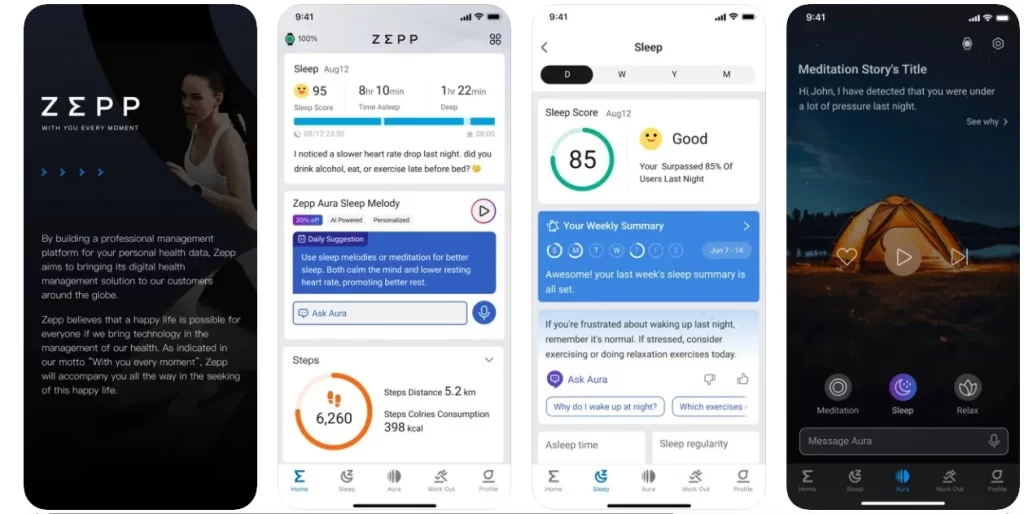
Zepp stands out as a leading fitness app with an impressive 10 million downloads on the Play Store. This app goes beyond basic tracking by offering in-depth insights and actionable guidance based on users’ data. Zepp doesn’t just record steps and heart rate; it delves into sleep patterns and overall health metrics. Users appreciate the personalized advice that aids them in achieving their fitness goals. Suppose you’re considering developing an app similar to Zepp. In that case, it’s an opportune moment to invest in a comprehensive fitness solution that caters to a wide range of health metrics and user preferences.
2. Peloton
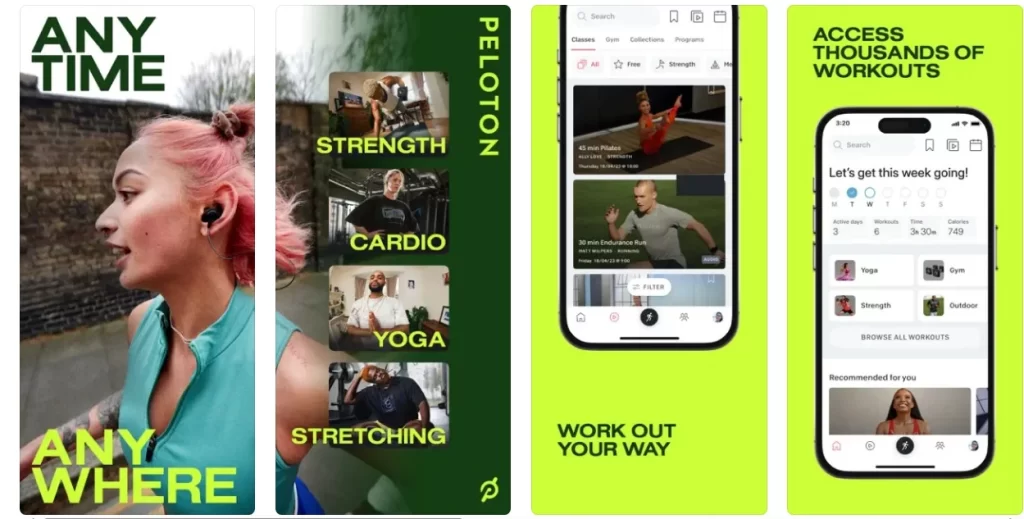
Peloton has gained widespread popularity for its premium workout equipment and virtual classes. The app allows users to monitor their progress, compete with friends on leaderboards, and receive virtual encouragement through high fives. Beyond just a fitness app, Peloton offers an immersive experience that brings the energy of group workouts to users’ homes. Whether users prefer intense cycling sessions or calming yoga classes, Peloton provides a diverse range of workouts to suit various fitness levels and preferences. If you’re envisioning an app that offers a similar engaging fitness experience, now is an ideal time to invest in creating a dynamic platform.
3. Fitbit

With an impressive 50 million downloads on the Play Store, Fitbit has become a household name in the world of fitness apps. Fitbit excels in providing comprehensive health tracking, allowing users to monitor not only their steps and heart rate but also sleep patterns, calories burned, and other vital health indicators. The app’s social features enable users to connect with friends, participate in challenges, and set personal fitness goals. If you’re considering developing an app akin to Fitbit, focusing on robust health tracking features coupled with a social and motivational aspect can make your app stand out in the competitive fitness app market.
4. MyFitnessPal
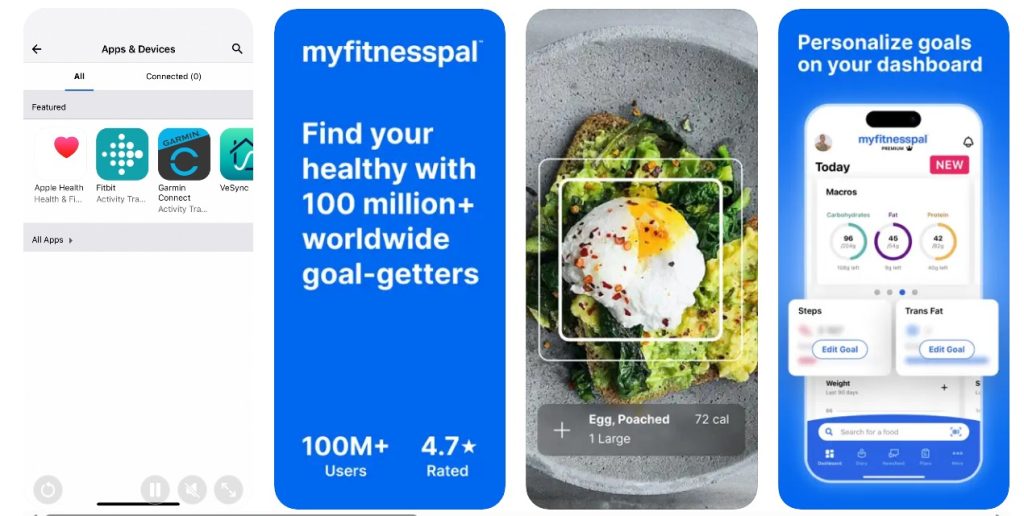
MyFitnessPal has gained popularity for its multifaceted approach to health and fitness. The app is renowned for its calorie-tracking functionality, acting as a comprehensive solution that includes daily workout sessions. It serves as a virtual diet consultant, meal planner, fitness tracker, and macro tracker all in one. MyFitnessPal’s ability to provide users with a holistic view of their health journey makes it a favored choice for those seeking an all-encompassing solution. If you’re planning to develop an app similar to MyFitnessPal, integrating features that address both nutrition and exercise can contribute to its success in a health-conscious market.
5. Hevy
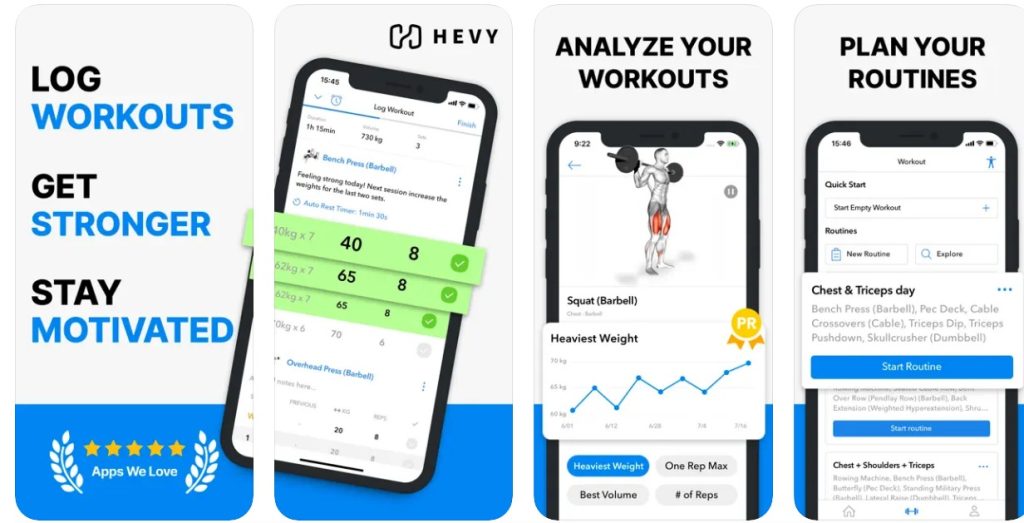
Hevy has carved a niche as the go-to weightlifting monitoring app, celebrated for its meal planning features. As fitness enthusiasts embrace weightlifting as a crucial aspect of their routines, an app like Hevy becomes invaluable. It goes beyond simple tracking, offering insights into optimal lifting techniques and personalized meal plans to support users’ strength-building journeys. When envisioning an app akin to Hevy for your fitness business, consider integrating unique features that enhance the weightlifting experience, such as expert tips, community engagement, and tailored nutritional advice. This ensures your app caters specifically to the needs and aspirations of weightlifting enthusiasts.
Tech Stack To Consider To Develop A Fitness App Like Fitcoach
Embarking on the journey to develop a fitness app similar to Fitcoach requires a strategic selection of cutting-edge technologies. In this comprehensive guide, we’ll explore the essential tech stack elements that can empower your fitness app to deliver a seamless and personalized user experience.
1. Front-end Development
- Swift (iOS)
- Kotlin (Android)
- Flutter (Cross-Platform)
2. UI/UX Design
- Adobe XD
- Sketch
- Figma
3. Back-end Development
- Node.js (JavaScript)
- Python (Django)
- Ruby (Ruby on Rails)
4. Database
- PostgreSQL
- MongoDB
- MySQL
5. Server Hosting
- Amazon Web Services (AWS)
- Microsoft Azure
- Google Cloud Platform (GCP)
6. Authentication
- OAuth
- Firebase Authentication
- JWT (JSON Web Tokens)
7. Mobile App Backend/API
- RESTful API
- GraphQL
8. App Development Frameworks
- UIKit (iOS)
- SwiftUI (iOS)
- Android SDK (Android)
9. Data Storage
- Amazon S3
- Google Cloud Storage
10. Wearable Device Integration
- Apple HealthKit API
- Google Fit API
11. Push Notifications
- Firebase Cloud Messaging (FCM)
- Apple Push Notification Service (APNs)
12. Analytics
- Google Analytics
- Mixpanel
13. Payment Gateway
- Stripe
- PayPal
14. Security
- SSL/TLS
- Data Encryption
- Regular Security Audits
Conclusion
Embarking on the journey to develop a fitness app akin to FitCoach involves a comprehensive understanding of the steps, unique features, and associated costs. Recognizing that fitness represents a significant challenge, requiring a lifestyle shift, underscores the importance of crafting an app that not only provides guidance but also addresses the holistic aspects of well-being. The insights gained from this blog offer a roadmap for translating your fitness app ideas into reality, emphasizing the need for expert guidance to navigate the intricacies of development.
Moving ahead, engagement with experienced individuals in the industry becomes critical. Working with experienced app developers, fitness experts, and user experience designers may give vital insight into ensuring that your app not only satisfies industry requirements but also connects with users on a personal level. This collaborative approach not only improves the quality of the fitness software, but it also streamlines the development process, potentially saving money and assuring a smoother launch.
As the fitness industry continues to embrace technological advancements, seizing the opportunity to contribute a unique and user-centric fitness app holds the potential for significant impact. With a solid foundation built on understanding, expertise, and collaboration, you can embark on the exciting journey of transforming your fitness app aspirations into a reality that inspires and supports users on their path to a healthier lifestyle.
How Idea Usher Can Help In Developing A Fitness App?
Idea Usher, a prominent leader in the mobile app development market, has established an industry norm in the competitive field. Our experienced developers have a track record of successfully developing varied fitness applications, pulling inspiration from FitCoach, Fitbit, Peloton, and others. With a focus to innovation and perfection, Idea Usher is a reliable partner for turning your fitness app ideas into attractive, feature-rich reality.
Idea Usher prioritizes cost-effective solutions for mobile and online development. Our team of professionals carefully examines mobile app development prices to guarantee that our clients receive high-quality applications while remaining within their budget.
By providing open and fair charges, we enable our clients to better manage their budgets, resulting in a smooth development process and the creation of high-quality fitness applications that stand out in the competitive market.
Here is a fitness app we have developed for our client, that you can check to gain an insight about our expertise in app development in the fitness industry.
Contact us to learn more about how we can help in developing your fitness app
Work with Ex-MAANG developers to build next-gen apps schedule your consultation now
FAQ
1. What is a Fitness App?
A. A Fitness App is a mobile application designed to enable users to engage in personalized training on the go, resembling a virtual workout coach. These apps are created to support users in maintaining their physical fitness by tracking progress and offering advice on nutrition and exercise.
2. What advantages come with creating Fitness Apps like FitCoach?
A. Developing a fitness app similar to FitCoach offers businesses the opportunity to boost sales, engage customers effectively, and cultivate brand loyalty. These apps are gaining popularity due to features such as progress tracking, personalized exercise routines, and health data integration.
3. How much does it cost to develop a Fitness App like FitCoach?
A. The cost of developing a fitness app like FitCoach can vary based on several factors. Key considerations include the complexity of features, such as personalized workout plans, real-time monitoring, and integration with wearable devices.
4. What are the top 5 Fitness Apps in the market?
A. Nike Training Club, Strava, Peloton, Fitbit and Hevy are some of the best fitness apps in the market.
